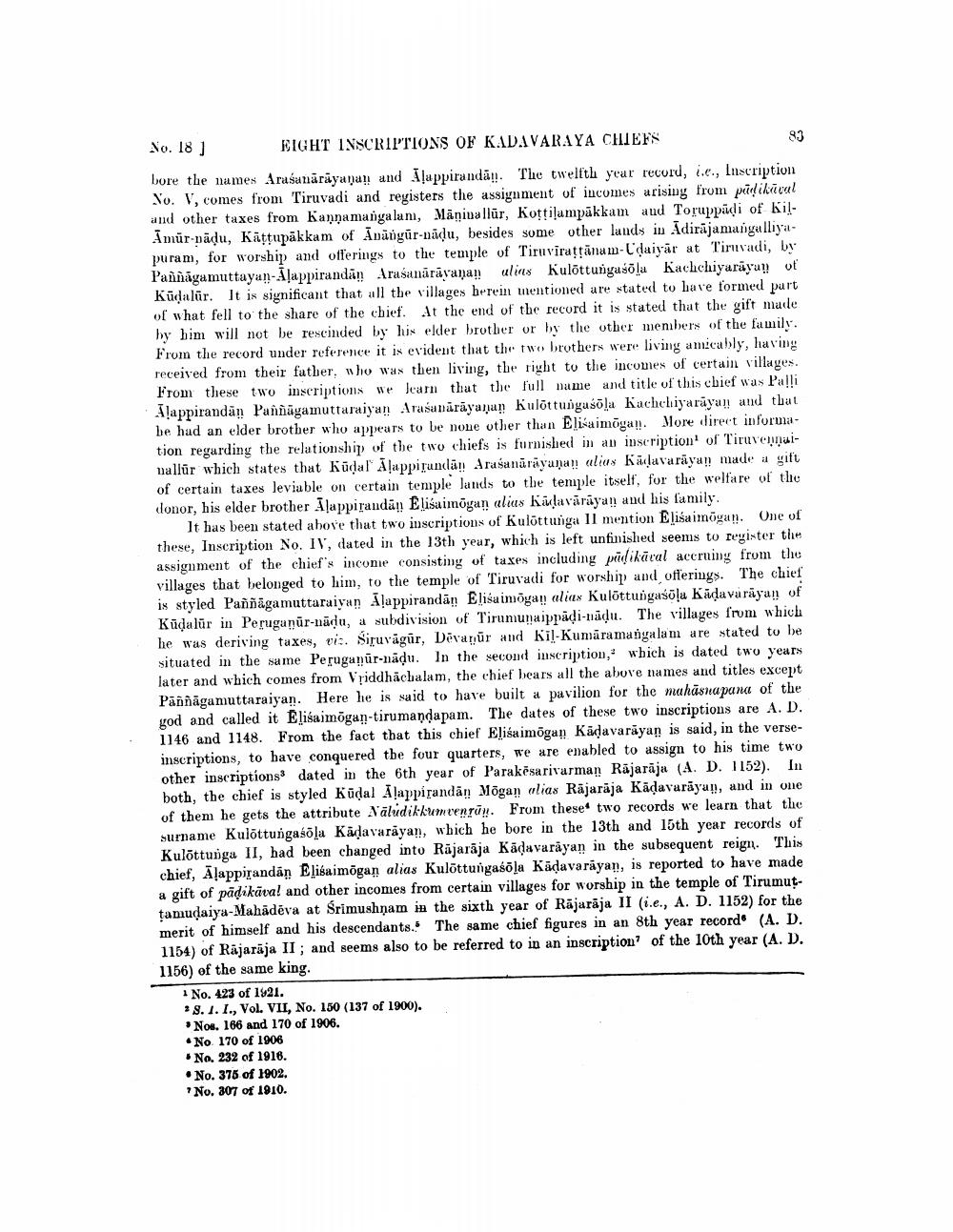________________
No. 18 ] EIGHT INSCRIPTIONS OF KADAVARAYA CHIEFS bore the names Arašanārāyanan and Ilappirandān. The twelfth year record, i.e., Inscription Yo. V, comes from Tiruvadi and registers the assignment of incomes arising from pidikivul and other taxes from Kannamangalan, Māniuallūr, Kottilampākkam aud Toruppüdi of KilAmūr-pādu, Kattupakkam of Apāngūr-nādu, besides some other lands in Adirajamangalliyapuram, for worship and offerings to the temple of Tiruvirattanam-Cdaiyar at Tiruvadi, by Pannagamuttayan-Alappirandan Arašanārāvanan ulins Kulottunyašola Kachchiyarávur of Kūdalür. It is significant that all the villages herein mentioned are stated to have formed part of what fell to the share of the chief. At the end of the record it is stated that the gift mude hy him will not be rescinded by his elder brother or by the other members of the family. From the record under reference it is evident that the two brothers were living amicably, having received from their father, who was then living, the right to the incomes of certain villages. From these two inscriptions we learn that the full name and title of this cbief was Palli Alappirandan Pannagamuttaraiyan Arašanārāyanan Kulottungašola Kachchiyarayal and that he had an elder brother who appears to be none other than Elisaimõgal!. More direct information regarding the relationship of the two chiefs is furnished in an inscription of Tiruvennuinallur which states that Kūdal Alappirundan rasanārāyanan alias Kälavarayan made a gift of certain taxes leviuble on certain temple lands to the temple itself, for the welfare of the donor, his elder brother Alappirandān Elisaimõgan alias Kalavarayan and his family.
It has been stated above that two inscriptions of Kulottunga II mention Elisaimõgan. One of these, Inscription No. IV, dated in the 13th year, which is left unfinished seems to register the assignment of the chief's income consisting of taxes including paidikäral aceruing from the villages that belonged to him, to the temple of Tiruvadi for worship and offerings. The chief is styled Paññāgamuttaraiyan Alappirandān Elisaimõgan alias Kulottungasõļa kādava rāyan of Kūčalūr in Peruganūr-nādu, i subdivision of Tirumunaippadi-nādu. The villages from which he was deriving taxes, vis. Siruvāgūr, Dévanur and Kil Kumāramangalam are stated to be situated in the same Peruganūr-nādu. In the second inscription, which is dated two years later and which comes from Vriddhāchalam, the chief bears all the above names and titles except Pāññāgamuttaraiyan. Here he is said to have built a pavilion for the mahāsuapana of the yod and called it Elisaimögun-tirumandapam. The dates of these two inscriptions are A. D. 1146 and 1148. From the fact that this chief Elisaimögun Käddavarayan is said, in the verseinscriptions, to have conquered the four quarters, we are enabled to assign to his time two other inscriptions: dated in the 6th year of Parakesarivarman Rājarāja (A.D. 1152). In both, the chief is styled Kudal Alappirandān Mögan alias Rājaraja Kādavarayan, and in one of them he gets the attribute Wāludikkumuenrūn. From these two records we learn that the surname Kulottungaśõla Kadavarayan, which he bore in the 13th and 15th year records of Kulottunga II, had been changed into Räjarāja Kādavarayan in the subsequent reign. This chief, Alappirandan Elisaimõgan alias Kulottungaśőla Kädavarayan, is reported to have made a gift of pädikāva! and other incomes from certain villages for worship in the temple of Tirumuttamudaiya Mahādēva at Srimushnam in the sixth year of Rājarāja II (i.e., A. D. 1152) for the merit of himself and his descendants. The same chief figures in an 8th year record (A. D. 1154) of Rājarāja II ; and seems also to be referred to in an inscription of the 10th year (A. D. 1156) of the same king.
1 No. 423 of 1921. * 8.1. I., Vol. VII, No. 150 (137 of 1900).
Nos. 166 and 170 of 1906. • No 170 of 1906
No. 232 of 1916. • No. 375 of 1902. No. 307 of 1910.




